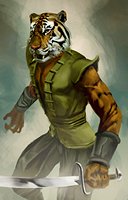Rakshasa

Introduction
Rakshasas are evil outsiders that are now native to the Material Plane. They are capable of taking any humanoid form. A Rakshasa's true form is that of a powerfully built Human with the head of an animal. They are commonly powerful sorcerers and they disdain physical fighting as ignoble.
Creating a Rakshasa on Arelith
Character Adjustments
Rakshasas may take the form of any playable humanoid race by using their innate ability and the -polymorph console command.
Note that this is a superficial appearance change, and does not provide the benefits of the race that the Rakshasa is imitating.
Abilities:
- +2 Dex
- +2 Cha
- SR 26
- 5/+2 DR
- +8 Bluff
- Skill Affinity: Listen
- Skill Affinity: Spot
- +10 to Seeing Track Details
+5 ECL
Notes
- Bonus Languages:
- Infernal
- Undercommon
Appearance
- Height: 6 to 7 feet tall (1,8 - 2,1 m)
- Weight: 250 to 300 pounds (110 - 140 kg)
- Hands: Backward facing
Rakshasa Shapechanging
When not shapeshifted, a Rakshasa will appear in its natural animal headed humanoid form.
Race Selection
Alternate races can be selected using the radial menu. For races with non-dynamic models, the Rakshasa can access two different models which will be selected randomly when shifting. (i.e. You have a 50% chance to turn into a Gnoll Warrior rather than a regular Gnoll.)
- Note: Head models of selected races can be changed via the -head command. If a head model would result in an invisible head after shifting, a random valid head model for that race will be assigned automatically.
Polymorphing
The same appearance will be used every time the Rakshasa polymorphs, until it is altered.
A Rakshasa never shows as "Rakshasa" when examined while shifted, instead their selected shifted form race will be displayed. Only by examining their unshifted form will their true race be revealed.
- Note: Polymorphing does not make the Rakshasa immune to disguise checks, so players are advised to invest in Bluff or Perform, in order to achieve effective disguises.
Outlook
Rakshasas believe that each and every creature in the universe has a proper role to play, and that success comes from understanding one’s position and working to improve it. Rakshasas don’t see castes as good or evil, but rather as purely pragmatic. Creatures of higher caste should be respected for their great power, and those of lower caste should be pressed into willing service to expand the holdings of those of higher castes as their betters seek greater wealth and influence. While rakshasas are forced to admit that the gods have powers greater than their own, most rakshasas scoff at the concept of divinity as a whole. The gods are among the most powerful beings in existence, to be sure, but too many examples of powerful, ambitious, or merely lucky mortals attaining divinity exist for rakshasas to pay religious homage to such creatures. Rakshasas see their own transitions from mortals to otherworldly beings as marks of their own fathomless potential and their initial steps on the path to godhood. However, the rakshasa do serve the planar power Ravanna a ten-headed being that was the paragon of their tyrannical ideals of decadence, cunning and narcissism. Most Clerics were chosen by Ravanna based on his needs and desires rather than them coming to serve him and it was practically suicidal by those who knew of him to ignore commands for such summons from his great priests
Mythology/Lifecycle
Rakshasas are born on the Material Plane, but they are not of it. They possess the powers and shapes of fiends, but their fates are inexorably tied to the mortal world, and it is there that they seek to rule. The reincarnations of manipulators, traitors, and tyrants obsessed with earthly pleasures, rakshasas are the embodiments of the very nature of materialistic evil. After dying violent deaths, these spirits are so tied to worldly decadence and selfish concerns that they take shapes that better reflect the baseness of their lives and are reborn as fiends. Thus have sages come to know these beings as the “earthbound evils.”
A rakshasa cannot impregnate another of its own kind, and so new rakshasas come into being via the coupling of a rakshasa and a non-rakshasa or, rarely, that of two non-rakshasas. A rakshasa born to non-rakshasa parents generally only occurs when one or both of the parents commits a great evil during the mother’s pregnancy, allowing the disembodied spirit of a previously slain rakshasa to reincarnate into the world by usurping the unborn offspring’s body. Rarely, such blasphemous births afflict good or innocent parents, typically in cases where the parents are exposed to great evils beyond their control. A rakshasa grows to maturity more quickly than a human, and often functions as a full-grown adult earlier than age 14. Despite this quick maturation, a rakshasa can live for 500 years or more before dying, at which point its spirit seeks a new host to be reborn in, continuing the vile cycle of fiendish reincarnation over and over again.
Polymorph Roleplay Tips
- The basic polymorph ability only changes your shape. It does not affect your mannerisms or way of speaking. Ranking up in Bluff or Perform reflects training to act like a member of another humanoid culture.
- For example, the polymorph widget only changes your shape to that of an elf. To affect elven grace, outlook, and reverence of the Seldarine, train in Bluff or Perform.
- When another PC sees past your disguise, they're spotting suspicious imperfections in your attempt to pass yourself off as a member of a different humanoid culture.
- For example, an astute spotter might notice that your battle axe is missing the traditional runic emblems of a Gold Dwarf of the Smoking Mountains, or that you lack the peculiar accent of the East Rift.
- As a disguise artist, give some thought to your alter ego personas. Develop descriptions of each, as well as an identity and a backstory. Doing so will alleviate suspicion and make your infiltration attempts more engaging and enjoyable all around. Shapeshifting is a core Rakshasa ability - enjoy it!
| Human | Human - Deep Imaskari - Firbolg - Half-Giant - Shadovar |
| Dwarf | Shield Dwarf - Gold Dwarf - Duergar - Wild Dwarf |
| Elf | Moon Elf - Aquatic Elf - Avariel - Fey'ri - Sun Elf - Wild Elf - Wood Elf |
| Gnome | Rock Gnome - Svirfneblin - Forest Gnome |
| Halfling | Lightfoot Halfling - Ghostwise Halfling - Strongheart Halfling - Fey |
| Half-Elf | Half-Elf - Gloaming - Green Hag - Kenku |
| Half-Orc | Half-Orc |
| Monstrous | Drow - Goblin - Kobold - Gnoll - Orog - Hobgoblin - Ogre - Minotaur - Imp - Troglodyte - Yuan-ti Pureblood - Derro - Rakshasa - Vampire - Grodd Goblin - Snow Goblin - Bugbear - Gith - Durzagon |
| Planetouched | Aasimar - Air Genasi - Earth Genasi - Fire Genasi - Water Genasi - Tiefling - Feytouched |
